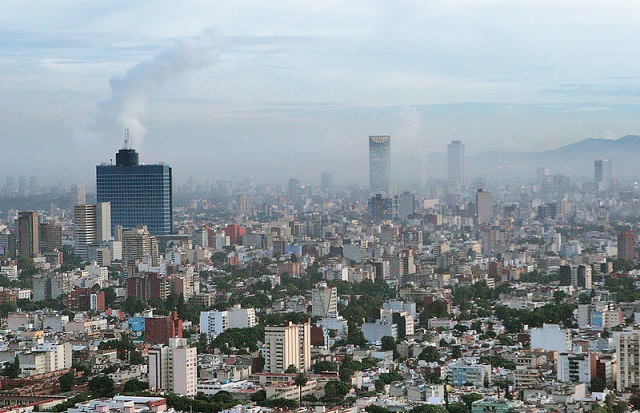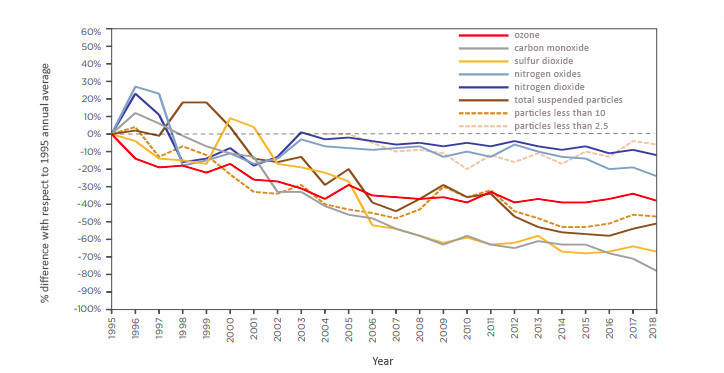
Today, air quality awareness is common among Mexico City’s residents. People with respiratory conditions are consulting the official reports of the Atmospheric Monitoring System (SIMAT, for its Spanish acronym) before engaging in outdoor activities more frequently. Education authorities are aware of pollution levels and inform thousands of public and private schools in the megalopolis when they are a risk to children’s health. The activation of environmental emergency events, known as Environmental Contingency (declared by the Environmental Commission of the Megalopolis) modifies the daily routine of the more than 20 million inhabitants of the city and its metropolitan area.
-Sensitive People: Do not engage in outdoor activities.
-All population: Avoid both moderate and vigorous physical activities outdoors.)
CareForYourHealth
Anticipating air quality conditions has become a necessity in the lives of city residents. The deterioration of air quality is an undesirable consequence of human activity: the massive use of fossil fuels to satisfy the city’s energy and transportation needs —nurtured by urban sprawl— emits thousands of tons of pollutants into the air every day. The dynamism of the atmosphere, allows the pollutants to dissipate, reducing the risk to the health of the population, although the same cannot be said for the health of the planet. However, there are times of the year when the layers of the atmosphere adjacent to the surface stabilize, decreasing the movement of air horizontally or vertically, causing pollutants to stagnate over the city, trapped between the walls that form the surrounding mountains. Solar radiation rapidly transforms the newly emitted pollutants into substances that are more toxic and harmful to human health. Therefore, knowing in advance how the atmosphere will behave, the amount and type of pollutants emitted, and their reactions in the atmosphere can help reduce the severity of an air pollution event, and especially mitigate health risks by easing decision making by all stakeholders involved.
Mexico City’s environmental authorities began laying the groundwork for the implementation of an air quality forecasting system in 2013 by acquiring the IT infrastructure, improving emissions inventories, and creating a working team. In 2015, the Barcelona Supercomputing Center was incorporated into the project, and in 2017 the Ministry of the Environment (SEDEMA, for its Spanish acronym) presented the Mexico City Air Quality Forecasting System, based on the WRF (Weather Research and Forecasting) meteorological model and the CMAQ (Community Multiscale Air Quality Modeling System) air quality model. Since then, this model is being used in meteorological and air quality forecasting, contributing to the calculation of the risk index for vulnerable people, as well as in the design and evaluation of air quality public policies.
Like any forecasting model, it is being continuously evaluated and improved. Objective and constructive scrutiny and criticism, both from academia and the general public, have contributed to identifying problems, weaknesses and areas of opportunity. Its use is undeniable as a tool that strengthens management capabilities, improves decision making and, in the medium term, contributes to an improvement in air quality.
Expanding the Impact

Mexico City and its metropolitan area, with more than 22 million people, is one of the largest megacities in the world. Since the 1990s, efforts have been undertaken to reduce concentrations of all pollutants (see Figure 1). Despite this, concentrations of ozone and particulate matter smaller than 2.5 micrometers (PM2.5) still fall above risk levels for the general population, mainly for the most vulnerable groups.
From the point of view of air quality management, Mexico City is an active laboratory where different management strategies are created and tested which, when successful, are often adopted by other local or regional governments.
![]()
Forecast by pollutant (SO2, in this case), generated by the Secretariat of Environment of Mexico City and displayed at www.aire.cdmx.gob.mx.
(Animation of the forecast for May 8th, 2021)
![]()
Forecast by pollutant (SO2, in this case), generated with SEDEMA data and visualized in Resource Watch for a wider area than Mexico City.
(Animation of the forecast for May 8th, 2021)
The quality of the forecast generated and published by the Ministry of Environment of Mexico City (SEDEMA), makes it possible to think of new ways of expanding its impact. An example of this is the collaboration with World Resources Institute (WRI), through which it is now possible to visualize SEDEMA’s data* in Resource Watch, which facilitates real-time monitoring of pollutants such as carbon monoxide (CO), nitrogen dioxide (NO₂), ozone (O₃), sulfur dioxide (SO2) and suspended particles (PM2.5). The visualizations acquire special value as they can be used by authorities and inhabitants of cities surrounding the capital, allowing them to take actions to protect health and avoid the exacerbation of very poor air quality events.
Due to the availability of SEDEMA’s data, coupled with Resource Watch’s visualization capabilities, it is now possible to access and visualize the same data for a wider area, reaching cities such as Toluca, Pachuca, Tepoztlán and Cuernavaca. This makes it possible to visualize the impact of pollutants emitted within a city, as well as those sources of emissions outside its jurisdiction.
Mexico City’s forecast for carbon monoxide (CO), visualized in Resource Watch for a wider area.
Mexico City’s forecast for nitrogen dioxide (NO2), visualized in Resource Watch for a wider area.
Visualizing the impact of pollutant sources inside and outside the cities’ jurisdiction helps authorities, emitters, and citizens to have a more complete view of the elements that affect their city’s air quality. For example, the forecast visualization published by Resource Watch shows the impact of pollutant emission sources outside the city’s area, such as industrial activity at the north or the impact of ozone produced in the Mexico City Metropolitan Area (MCMA) on agricultural areas in the central region of the country. In addition, the visualization also allows citizens and authorities in neighboring cities to use the forecast to take actions to protect their health and avoid exacerbating high pollution events, even though they do not yet have their own forecast models.
Mexico City’s forecast for ozone (O3), visualized in Resource Watch for a wider area.
Mexico City’s forecast for suspended particles (PM2.5), visualized in Resource Watch for a wider area.
Thus, Mexico City, in collaboration with WRI and Resource Watch, facilitates the visualization of pollutants over a wider area than that reported by the Mexico City website, expanding the impact of the model to a larger population at a minimal cost.
WRI seeks to transform cities around the world by translating scientific knowledge into policies, laws and projects that improve human health and quality of life. In addition to its research work, WRI seeks to collaborate with governments in identifying and scaling up successful approaches from some cities to other regions. WRI’s Air Quality team works to access data that can be openly visualized on Resource Watch as a tool for understanding and addressing the challenge of achieving clean air.
*Although visualization is achieved from data provided by Mexico City’s SEDEMA, the model’s performance is not validated by that agency for areas outside the Mexico Valley Metropolitan Zone.
This article was originally posted on Resource Watch.
We’d like to specially acknowledge Amelia Snyder and Eduardo Castillero, who worked in the processing, maintenance, and visualization of Mexico City’s data, which resulted in the maps that are now live in Resource Watch.
Beatriz Cárdenas is Director of Air Quality for WRI Mexico and a global air quality co-leader.
Mónica Jaimes is Deputy Director of Analysis and Modeling at Mexico City’s Ministry of Environment.
Armando Retama is a specialist in air quality issues and collaborates as a consultant with WRI Mexico.
Olivia Rivera is Director of Air Quality Monitoring at Mexico City’s Ministry of Environment.








